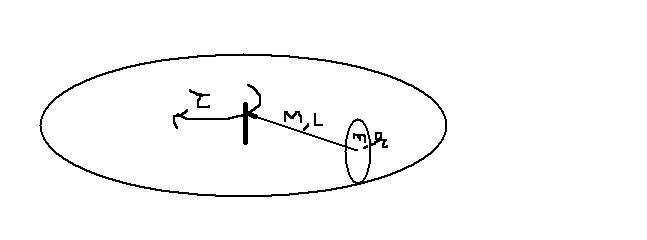no i am far far away from the answer [2]
sorry i can't help u here [2]
A uniform disc of mass m and radius r is rolling on a circle by virtue of torque Ï„ given to rod(mass M length L) pivoted to disc.Find angular accelrations of rod and disc.
actually you are very close.....
here are the answers::
Ï„/L2(2M+9m) and Ï„/Lr(2M+9m)
no i am far far away from the answer [2]
sorry i can't help u here [2]
Ok..............But can u tell me how u got ang acc of disc= 3Ï„
Lr(M+3m)
Leave it..
It is wrong...
:(
and u will get confused bekar me..
its not worth solving..
[3](dur ke angur khatte hai isliye)
There are 2 rotations involved..
in is along the axis of the rod.
the other is by the center..
(Does this hint work enuf for finding the moment of inertia?)
I have been scratching my head for over a week.............plzzzz send the solution........I am getting mad.......
I have been scratching my head for over a week.............plzzzz send the solution........I am getting mad.......
I know the ans is diffcult but iwill find it out Mr. u rekal.
give me some time
inertia along the axis of the rod is mr2/2
inertia along the center will be ML2/3 + mr2/4+mL2
Just check that this is correct!
this is correct but how to get the ans. bhaiyya
i wrote some eqns but could not get the ans eureka has given
can you write the eqns. so that i correct mine
I will try to give some more hints... (I din solve it myslef... but see if this helps!)
Take friction ... call it F
and then find the total torque due to friction and applied torque... at the central rod...
THen use torque = I alpha
again there is torque along the central axis of the rod.. and there is rotation or angular acceleration ... again due to friction alone
also there is a relation between these two torque....
Use the moment of inertias that i put above... i guess that should help :)
wil the net Ï„ about the central axis be equal to (tau) - FL or will it be something else?
ok here are my equations please point out the mistake in them
(tau) - FL= Iα (1)
(tau)/L - F = ma where a =αL (2)
Fr =(mr2/2)a/r (3)
but this does not give the ans
[2] what's wrong
maybe 2nd eqn is doubtful
philip we are dealing with 2 different angular accelerations..
i think in the second equation u have used the same angular acceleration as the first ....